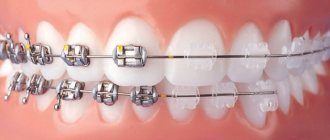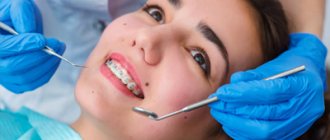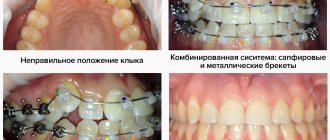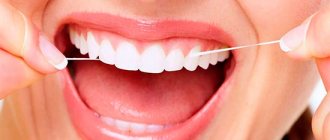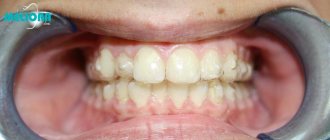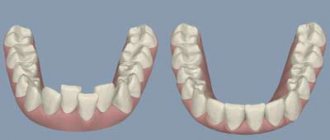Types of self-ligating structures | Alternative solution | Comparison of self-ligating and ligature braces | Classification by material of manufacture | Fixation methods | Reviews from orthodontists
Self-ligating braces have high aesthetic performance and reduce the number of visits to the orthodontist by the patient. The key difference between the designs and traditional models with ligatures is the closed locking mechanism. When closed, the lock turns the groove into a tube. The arc is securely fixed in the groove, straightens, but at the same time slides without obstacles.
The material was verified by Anna Rimkevich, senior product manager at Ormco Russia.
The innovative mechanics of the Damon self-ligating brace system in the hands of an experienced doctor can reduce trauma and provide predictable treatment results in a short time. The effectiveness of passive self-ligation, high-tech arches and a minimally invasive treatment protocol has been proven by scientific laboratory tests and in practice by orthodontists.
Appliances without ligatures first appeared in the 1930s, and the first Damon self-ligating braces appeared in 1996. Since then, the designs have been improved every year by doctors, inventors and scientists. There is a large selection of Ormco ligature-free systems on the market: Damon Q, 3MX, Clear, etc. With each new generation, the models become sleeker, more technologically advanced and safer for the patient.
arch in the groove of the Damon Q2 self-ligating bracket
What are self-ligating braces?
For many years, classic ligature braces have been used to correct dental anomalies. They consisted of clasps glued to the teeth and a metal arch attached to them. The arch in such a system is attached to the clasps with ligatures - elastic rings or wire rings, and to the side teeth - with metal rings. The arch is fixed so that its traction helps straighten the teeth in the right direction. Ligature braces are still widely used today, but they require frequent visits to the doctor to correct the tension of the arch and change the ligatures (they quickly stretch and change color).
In the mid-90s of the last century, a new type of braces systems appeared - non-ligating or self-ligating. The difference between self-ligating braces and ligature braces is that instead of ligatures, they use special caps with clasps, through which an arch is threaded, like through channels. Getting rid of ligatures brought significant relief both to the orthodontist when installing braces and to the patient while wearing them. Currently, both ligature and non-ligature braces are used.
Differences between ligature and self-ligating braces
Metal or sapphire
Self-ligating brackets today are made of metal or polycrystalline aluminum oxide (synthetic sapphire). Both of these materials have their pros and cons. Thus, the metal has higher strength and allows treatment to be completed in a shorter time. Also, the doctor can change the arches in a higher sequence, and also use steel arches. They are distinguished by high rigidity, plasticity, and the ability to form bends and loops of the desired configuration. Also, steel arches are very affordable.
Sapphire products require more careful handling. Replacement of arcs is done more delicately, using super-elastic products made of nitinol (an alloy of nickel and titanium), an alloy of nitinol and copper. However, for the patient, sapphire braces are always preferable. They are almost invisible, transparent, very smooth and stylish. This allows you to eliminate the psychological discomfort associated with wearing an unaesthetic metal system.
Advantages and disadvantages of non-ligature systems
Self-ligating non-ligature braces have a number of advantages over classic ligature braces. They:
- thinner, more elegant, less noticeable;
- provide easier adaptation of the patient to them;
- are installed quickly, since there is no need to attach the arc separately to each lock, it is simply threaded through the caps;
- allow precise adjustment of the system taking into account the required trajectory;
- do not require frequent correction: you need to visit the orthodontist no more than once every two months, whereas after installing ligature braces - once a month or even more often;
- physiological, do not have a negative effect on periodontal tissues;
- reduce the duration of correction;
- do not require much maintenance effort compared to ligature ones (food debris gets stuck mainly in the ligatures).
The disadvantage of non-ligature self-ligating braces is their higher price compared to ligature ones.
Description of ligature braces
The figure shows how the power arch is attached to the bracket pad: the ligature firmly fixes the arch, preventing it from moving.
In ligature systems, 2 fastening options are used:
- rubber rings. They can be colorless, white or colored. They deform (stretch) quite quickly, so they must be replaced every 3 to 4 weeks. As a rule, they are used in the initial stages of therapy, because with their help the arc exerts a mild force effect;
- wires made of steel, aluminum or silver alloy. The arch is secured with such ligatures at the final stages of treatment.
Ligature orthodontic devices cope with pathology of any severity, if it is, in principle, subject to conservative treatment. These braces can be metal or ceramic. Metal ones have a lower cost, but are inferior to ceramic ones in terms of aesthetics. Therefore, our dentists recommend ceramic braces to those patients who would like to look as attractive as possible during treatment.
Types of self-ligating braces
Liature-free braces are divided into types according to their mechanism of action, material of manufacture and brands of individual manufacturers (brands).
By mechanism of action
Based on this feature, ligature-free braces are divided into two types:
- active – the cap (clip) exerts active pressure on the arc, forcing it to move in the desired direction;
- passive - the lid does not affect the arc in any way, it simply holds it in the lock; it is believed that this is a more natural type of correction that does not injure the periodontal tissues.
By material
Metal and ceramic self-ligating systems
Self-ligating braces are made from metal, dental ceramics and artificial sapphires. The strength and volume of the model, as well as indications for its use and aesthetics, depend on the material of manufacture.
Metal self-ligating braces
The most popular and reliable non-ligature models. Advantages:
- durable, reliable bracket systems, do not break, suitable for correcting any anomalies;
- easy to install and remove;
- cheaper than models made from other materials.
The disadvantages of metal structures include their low aesthetics: metal braces, even with the smallest locks, will always be visible when you smile.
Ceramic self-ligating braces
Also popular models are made of durable white dental ceramics in different shades. They are installed by patients who want to look more aesthetically pleasing. Advantages of metal self-ligating bracket systems:
- lighter and more comfortable to wear;
- you can choose the color of the locks exactly to match the color of your own teeth and they will be invisible, since they do not give glare;
- the adaptation period passes quickly, there is practically no discomfort or speech impairment;
- do not injure the soft tissues of the oral cavity.
Disadvantages of ceramic structures:
- more fragile compared to metal ones, sometimes they break and are not used for the correction of complex malocclusions;
- more expensive than metal ones;
- the metal arc is still visible when you smile.
Sapphire self-ligating braces
Made from transparent artificial sapphires, characterized by high strength and brilliance. Advantages:
- aesthetics - the reflection of light makes the metal arch less noticeable and gives the smile a radiance;
- stronger than ceramic ones, but inferior in strength to metal ones; therefore, they are used to correct some complex malocclusions, but still not all;
- do not have a negative effect on surrounding tissues.
Disadvantages of sapphire models:
- require more careful care, as they can quickly lose transparency due to plaque;
- the most expensive.
By brand
Global manufacturers are constantly improving their models and brand lines. Externally similar designs can differ significantly in their properties and correction efficiency. Below you can find the most popular brands of self-ligating braces.
Self-ligating Damon braces (Ormco, USA)
The Damon line of self-ligating braces is the most popular in our country. The designs are easy to use and reliable due to improved valves with locks, allowing you to quickly install and remove the system. Popular Damon (Daimon) models:
- Damon Q self-ligating braces - a comfortable and ultra-reliable design made from a hypoallergenic metal alloy, is very popular among orthodontists and their patients. A passive type of traction is used, which allows you to cope with any anomalies of the dentition in a shorter time compared to other systems. Small clasps help patients quickly adapt and do not cause them discomfort when wearing braces. The model costs a lot, but is cheaper than designs made from other materials;
- Damon Clear are aesthetic ceramic braces made of highly wear-resistant material based on aluminum. The improved locking shutter allows for quick installation and removal of the system. The model is reliable, but less durable than metal structures, so it is not used to correct complex malocclusions, and it is also very expensive.
Damon Q braces
Damon Clear braces
Clarity SL (3M Unitek, USA)
The company is a leader in the production of bracket systems: the Clarity SL model of self-ligating ceramic braces successfully competes with Damon Clear. Increased reliability of the design is provided by the use of metal to strengthen the channels (the arc passes through them) in the locks. The model is aesthetic and almost invisible on the teeth, but is not intended for the correction of complex anomalies. But its price is lower than that of Damon Clear.
Clarity SL braces
Experiense (GC Orthodontics, Germany)
German products are traditionally of high quality. Experience metal – self-ligating braces of high reliability due to clasps made of ultra-strong, non-oxidizing metal. They are cheaper than the Damon Q system, but are in no way inferior to it in quality, and are used to correct malocclusions of any complexity.
In Ovation (Dentsply, USA)
The In Ovation (Innovation) line from the American company Dentsply is also distinguished by its aesthetics and reliability. It includes models:
- In Ovation R are metal self-ligating braces with a special locking design that allows you to set the desired arch tension and distance between the locks. The design is very reliable and can be used to treat complex malocclusions;
- In Ovation C is a ceramic aesthetic model. The clasps are coated with zirconium dioxide to prevent discoloration. The design features of the model prevent its incorrect installation. These are high quality braces and are cheaper than Damon Clear.
In Ovation R braces
Self-ligating brackets H4 (Ortho Classic, USA)
H4 are high quality metal self-ligating braces made from fully biocompatible metal. Their special feature is the miniature clasps, located as close as possible to the gums, so that the h4 system is practically invisible when smiling. The system is comfortable to wear and does not irritate soft tissues.
H4 braces
Brand lines of Forestadent, Germany
The oldest German company presents a line of four self-ligating models:
- QuicKlear is a self-regulating ceramic design. A special feature is a metal flap with clasps for threading the arc. The flap is polished, has a matte color and almost does not differ from the locks in color, the locks are flat, their edges are rounded. They actively influence the arc, ensuring its movement in the desired direction. This is a reliable and beautiful model;
- TruKlear is an improved version, a ceramic self-ligating model with a ceramic lid. Special ceramics do not change its color, which is why the design is almost invisible on the teeth;
- BioQuick – active self-ligating ceramic braces with small clasps. A special feature of the design is the quick fixation of the locks with special protrusions on their base. The force holding the arc in the groove allows it to be moved in the desired direction;
- BioPassive – passive self-ligating ceramic braces. Passive action is achieved through a flexible cap and deep grooves that reduce arc friction. Effective correction is combined with a soft, non-traumatic effect on periodontal tissues.
Operating principle of self-ligating systems
Scientists are constantly looking for innovative solutions that will straighten teeth with maximum comfort and in a short time. A breakthrough in this area was the invention of self-ligation technology. This principle implies that the arc is held in the groove without the help of wire or elastic ligatures. It is fixed in place using a special smooth cover. This cover is an integral part of the design of the bracket itself. It covers the arc and prevents it from slipping out of the groove. There are two types of self-ligating systems:
- Active self-ligation - the cover presses on the arc, pressing it tightly to the bottom of the groove.
- Passive self-ligation - the cover does not put pressure on the arc, it can slide freely in the groove.
Passive self-ligation is considered preferable. It avoids friction and excessive impact on the periodontium and bone tissue. In such a system, tooth movement is carried out by weak, physiological forces. The gentle effect on the dental system contributes to patient comfort. at the same time, the system is characterized by very high efficiency.
Indications for installation
Self-ligating braces are installed to correct the following anomalies:
- malocclusion - improper closure of teeth; metal models are used to correct complex malocclusions, which eliminates the need for surgery;
- curvature, uneven position, crowding of teeth or large gaps (three spaces) between them;
- unerupted (impacted) teeth – braces help to pull them out:
- disorders of the temporomandibular joint, causing difficult painful movement of the jaws, increased muscle tone;
- displacement of the dentition caused by prolonged absence of teeth, leading to facial asymmetry;
- to improve the appearance of the face in profile;
- in preparation for prosthetics or implantation to expand the gap between teeth, if the tooth has been missing for a long time and the gap has decreased.
The orthodontist decides together with the patient whether to choose self-ligating or ligature braces. The approach to selection should be individual, taking into account the characteristics of the existing pathology, aesthetic preferences and the cost of the design. Ligature-free braces are more expensive and do not require frequent visits to the doctor, so they are more often installed on adult patients. Children (not earlier than 8–9 years old and only on permanent teeth) and adolescents can have both types of braces installed, but they are still more often fitted with metal ligature models. Read more about braces for children here.
Ceramic and sapphire models are not suitable for children, as they are quite fragile and can injure a child if broken.
Contraindications
The installation of self-ligating structures also has contraindications. They can be absolute (correction is never carried out) and relative (correction can be carried out under certain conditions or after some time).
Absolute contraindications include:
- some common diseases that lead to decreased immunity and increased risk of infection of periodontal tissues - diabetes mellitus, immunodeficiency, blood diseases, cancer;
- severe chronic infections - AIDS, open tuberculosis;
- mental illnesses that prevent the patient from contacting the orthodontist, epilepsy;
- changes in the bone tissue of the jaw (atrophy, osteoporosis) - a thinned bone may not withstand the load;
- the absence of several teeth in the dentition at once - treatment should be carried out by an orthodontist together with an orthopedist.
Relative contraindications:
- infectious and inflammatory diseases of the oral cavity, teeth and periodontal tissues - stomatitis, caries, periodontitis;
- degenerative-dystrophic periodontal diseases - periodontal disease;
- the presence of implants and fixed dentures in the dentition - the issue of installing braces should be decided by the orthodontist together with the orthopedist;
- bruxism – grinding of teeth, mainly during sleep;
- allergies to dental materials – selection of materials will take some time;
- pregnancy and lactation;
- any acute diseases and exacerbation of chronic diseases.
Installation of self-ligating braces
When making an appointment with an orthodontist in the clinic, the patient must be asked for consent to the processing of personal data. The installation of any braces system consists of several stages: diagnosis, treatment of the identified pathology and the actual installation of braces.
Diagnostics
To install a bracket system, you must first make sure that there are no contraindications for this procedure. During the consultation, the orthodontist carefully examines the patient and then sends him for an additional examination: a survey radiography of the upper and lower jaw to identify bone tissue pathology. If necessary, a computed tomography (CT) scan of the jaw and magnetic resonance imaging (MRI) of the temporomandibular joint are performed, and a referral is made to a dentist-therapist. The therapist examines the oral cavity, identifies caries and inflammatory gum diseases.
Treatment
All identified pathologies are treated: carious teeth, stomatitis. If necessary, damaged teeth are removed. Periodontitis and periodontal disease are treated to a state of stable remission. This is followed by professional teeth cleaning and polishing.
Installation of non-ligature systems
The orthodontist installs a mouth opener, cleans and dries the teeth. After this, step by step:
- glues a lock to each tooth using special dental cement; for final fixation, the adhesive-cement is treated with ultraviolet rays, and its remains are removed; Most often, the structure is installed first on one jaw - the upper one, and after 2 weeks - on the lower one - this makes adaptation easier;
- when the cement has completely hardened, an arc is pulled through the grooves of the locks and each lock is closed with a lid; they snap tightly and securely hold the metal arc; the structure is secured on the sides with rings on the chewing teeth, most often 6 or 7.
During installation, the patient does not experience pain. The entire procedure for installing self-ligating braces lasts about an hour. You will need to visit the orthodontist once every 2 months to monitor and adjust (activate) the system.
Types (q and q2)
Damon Q2 are the most effective models of braces for bite correction that are used in the clinic. They have the following design features:
- Damon Q. The model is made of high-strength steel and is used to correct bites in difficult situations. Double puzzles make it easy to adjust the treatment process and, if necessary, introduce additional elements. The compact design has a rounded, streamlined shape and is easily secured in the oral cavity using Spin Tek clamps. Recommended for adolescent and adult patients.
- Damon Q2. Belongs to the eighth series of braces, this is an improved design that is safe for the patient’s health. It has good control of the rotation of the dental unit around the axis, which speeds up and facilitates bite correction. The increased subligature space makes it easy to increase or change the traction and direction of the arc. Rounded corners do not damage mucous membranes. The absence of rigid fixation does not disrupt the blood supply and innervation of soft tissues.
In each case, the choice of braces is carried out after preliminary diagnosis.
Caring for self-ligating braces
Non-ligature braces are easier to care for than ligature braces, as food is less likely to get stuck in them. But careful care is necessary, otherwise bacterial plaque will form on the teeth and caries will begin. To prevent this from happening, you need to maintain oral hygiene:
- brush your teeth twice a day with a special V-shaped toothbrush;
- After each meal, even after drinking juice or milk, rinse your mouth thoroughly; If there are food particles left in the teeth, they can be removed with a stream of water from an irrigator or using an interdental brush.
You should also follow the nutritional recommendations:
- in the first week after installing the system, you need to eat soft food, then gradually switch to harder food; but foods such as nuts and seeds will need to be excluded;
- limit the consumption of sweets and sugary drinks - this is an excellent breeding ground for bacteria;
- You should not eat foods that stick to your teeth – chewing candies, chewing gum.
Treatment with orthodontist Irina Butorina
Enjoy the benefits of modern ligature-free braces! The world's leading manufacturers of orthodontic products are now working to improve the aesthetics and comfort level of braces. Self-ligating systems are an important step in this direction. You can undergo diagnostics and correct your bite using a sapphire, ceramic or metal self-ligating system from orthodontist Irina Butorina . An experienced doctor will help you choose a system that will suit you at a price and meet your aesthetic requirements. Sign up for a consultation by phone or using a special form on the website.
If you are interested in the offer, you can sign up for a free consultation right now.
Possible complications
With proper installation, there are practically no complications, but in the first 1 - 2 weeks unpleasant symptoms may appear:
- discomfort in the oral cavity; with non-ligature models, which are small in size, this goes away quickly;
- speech impairment - disappears within 2 - 4 weeks; to speed up the process, you need to talk and read aloud more;
- dry lips – this symptom may bother you during the entire period of wearing braces; it can be reduced with the help of special moisturizing cosmetics;
- pain in the teeth - if the surrounding soft tissues are not inflamed, then this is due to the movement of the teeth in the desired direction; after some time, the tissues adapt to the impact, and the pain goes away;
- pain associated with irritation of the gums, tongue and inner surface of the cheeks; to prevent inflammation from developing, it is recommended to rinse your mouth with antiseptic solutions - infusion of chamomile flowers, calendula, Miramistin; over time all this passes;
- headaches - they are not so common, but sometimes wearing braces provokes their appearance; in such cases, you need to visit an orthodontist, make sure that the system is installed correctly, and then contact a neurologist.
Urgent medical attention is required if the following symptoms appear:
- redness, swelling of the gums, the appearance of ulcers in the mouth with an increase in body temperature, loosening of teeth, increasing pain - these signs appear as a result of improper installation of the system;
- the appearance of carious spots on tooth enamel.
How much does it cost to install ligature-free braces?
The cost of installing self-ligating braces consists of:
- cost of examination and preliminary treatment;
- the orthodontist’s work on installing the structure;
- prices of braces depending on the brand;
- geographic location and reputation of the clinic.
Approximate prices for different brands of non-ligature braces for one jaw:
- Damon Q: 27–50 thousand rubles.
- Damon Clear: from 60 thousand rubles.
- In-Ovation R: 40 thousand rubles.
- In-Ovation C: from 45 thousand rubles.
- Activation of a self-ligating brace system from RUB 2,800.


